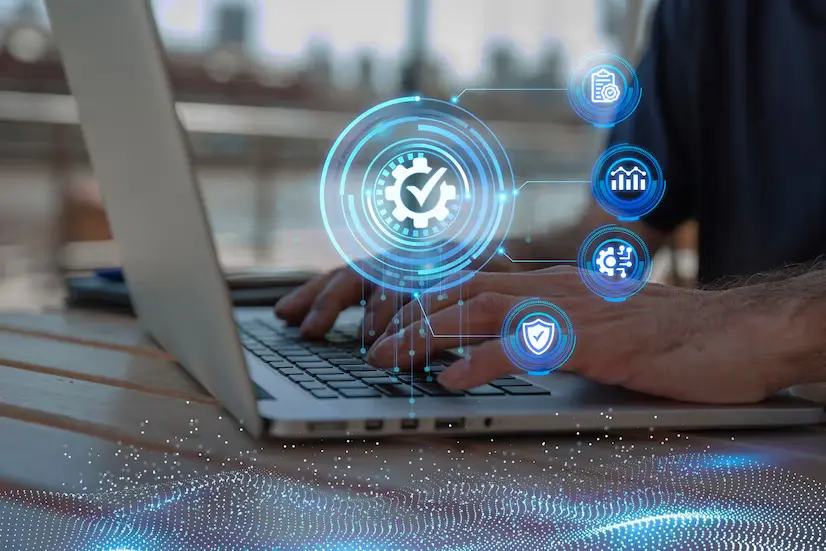How to Develop an Effective Approach to Cybersecurity?
- 1 Developing an Effective Approach to Cybersecurity?
- 1.1 Develop a comprehensive cybersecurity plan.
- 1.2 Implement strong passwords and access controls.
- 1.3 Keep software and systems up to date.
- 1.4 Educate employees on cybersecurity best practices.
- 1.5 Implement firewalls and antivirus software.
- 1.6 Conduct security assessments regularly.
- 2 Why is Cybersecurity Important for Organizations?
Cybersecurity refers to the technologies and processes that protect systems, networks, devices, and data from cyberattacks. In today’s digital world, cybersecurity is more important than ever. That’s because of the rise of cyberattacks like hacking, malware, and phishing.
Companies across industries are undertaking a practical approach to cybersecurity to prevent cyberattacks and protect sensitive information.
Here are a few steps to develop a practical approach to cybersecurity.
Developing an Effective Approach to Cybersecurity?

Develop a comprehensive cybersecurity plan.
A cybersecurity plan must include a list of potential threats and vulnerabilities to your organization’s systems, networks, and data. It also outlines how you will protect your organization from these risks.
Implement strong passwords and access controls.
Weak passwords are considered to be one of the most significant vulnerabilities. Therefore, you must have a solid password to implement a practical cybersecurity approach. Additionally, you can also use multi-factor authentication to add an extra layer of security and restrict
Keep software and systems up to date.
You can avoid software vulnerabilities by keeping software and computer systems up to date. Additionally, it would be best to keep updating operating systems, web browsers, and plug-ins to prevent different types of attacks.
Educate employees on cybersecurity best practices.
Companies must train their employees on cybersecurity best practices. They should also train their workforce to identify threats such as phishing emails, social engineering attacks, and other common tactics cybercriminals use. Moreover, employees should be taught how to respond to a security incident.
Implement firewalls and antivirus software.
Firewalls block unauthorized access to your network, while antivirus software detects and removes malware. Thus, both are essential tools for protecting against cyber threats.
Conduct security assessments regularly.
Regular security assessments can identify potential vulnerabilities and risks, allowing you to fix them before a security breach occurs.
Why is Cybersecurity Important for Organizations?
As discussed earlier, cybersecurity is pivotal in protecting an organization’s sensitive data. Here’s a closer look at the importance of cybersecurity in businesses.
Protecting Sensitive Data
Protecting sensitive data is one of the primary reasons cybersecurity is crucial for organizations. Organizations handle sensitive information, including financial records, personal customer data, intellectual property, and confidential business strategies. A data breach can lead to severe consequences, including economic losses, legal liabilities, and damage to customer trust.
Financial Records: Financial data is often the target of cybercriminals seeking to commit fraud or theft. Unauthorized access to financial records can result in significant financial losses and operational disruptions. For instance, cybercriminals may manipulate financial transactions, steal funds, or engage in identity theft, posing a substantial threat to an organization’s financial stability.
Customer Data: Protecting customer data is a legal obligation and a matter of trust. Customers expect organizations to safeguard their personal information, including names, addresses, social security numbers, and credit card details. This data breach can lead to identity theft, financial fraud, and a loss of customer trust, which can be challenging to rebuild.
Intellectual Property: For many organizations, intellectual property (IP) is a valuable asset differentiating them from competitors. Cyberattacks targeting IPs can result in the theft of trade secrets, proprietary technologies, and research and development data. This can undermine an organization’s competitive advantage and result in significant financial losses.
Maintaining Business Continuity
Business continuity refers to an organization’s ability to maintain essential functions during and after a disaster or disruptive event. Cyberattacks like ransomware, denial-of-service (DoS) attacks, and malware infections can severely disrupt business operations. Ensuring robust cybersecurity measures helps organizations maintain business continuity and minimize downtime.
Ransomware: Ransomware attacks involve encrypting an organization’s data and demanding a ransom for release. These attacks can paralyze operations, leading to significant financial losses. Effective cybersecurity measures, such as regular data backups and robust incident response plans, can mitigate the impact of ransomware attacks.
Denial-of-Service (DoS) Attacks: DoS attacks overwhelm an organization’s network or website, rendering it unavailable to users. This can result in lost revenue, damaged reputation, and customer dissatisfaction. Implementing robust cybersecurity protocols, including network monitoring and intrusion detection systems, can help prevent and mitigate the impact of DoS attacks.
Malware Infections: Malware can infiltrate an organization’s systems, disrupt operations, steal sensitive data, or cause system failures. Employing comprehensive cybersecurity measures, such as antivirus software, firewalls, and employee training, can reduce the risk of malware infections and ensure business continuity.
Ensuring Regulatory Compliance
Organizations must comply with various regulations and standards to protect sensitive data and ensure the privacy of individuals. Failure to comply with these regulations can result in hefty fines, legal penalties, and reputational damage. Cybersecurity is critical in helping organizations meet regulatory requirements and avoid legal consequences.
General Data Protection Regulation (GDPR): The GDPR imposes strict requirements on organizations handling the personal data of EU citizens. Non-compliance can result in significant fines, making organizations need to implement robust cybersecurity measures to protect personal data and ensure compliance.
Health Insurance Portability and Accountability Act (HIPAA): HIPAA mandates the protection of sensitive health information. Healthcare organizations must implement comprehensive cybersecurity measures to safeguard patient data and comply with HIPAA regulations, avoiding potential fines and legal repercussions.
Payment Card Industry Data Security Standard (PCI DSS): Organizations handling payment card information must comply with PCI DSS requirements to protect cardholder data. Failure to comply can result in substantial fines and the loss of the ability to process payment cards. Strong cybersecurity measures are crucial for meeting PCI DSS requirements and protecting payment card information.
Preserving Organizational Reputation
An organization’s reputation is one of its most valuable assets. A single cybersecurity breach can have far-reaching consequences, damaging the organization’s reputation and eroding customer trust. Preserving a solid reputation requires a proactive approach to cybersecurity.
Customer Trust: Customers are increasingly concerned about the security of their personal information. A data breach can lead to a loss of customer trust, resulting in customer churn and decreased revenue. Organizations prioritizing cybersecurity demonstrate their commitment to protecting customer data, fostering trust, and maintaining long-term relationships.
Brand Image: A cybersecurity breach can attract negative media attention and damage an organization’s brand image. Rebuilding a damaged reputation can be a lengthy and costly process. By investing in robust cybersecurity measures, organizations can protect their brand image and maintain a favorable public perception.
Competitive Advantage: Organizations with a strong cybersecurity posture can differentiate themselves from competitors. Committing to cybersecurity can attract customers, partners, and investors who prioritize data security. A strong reputation for cybersecurity can be a competitive advantage in today’s digital marketplace.
The Evolving Cyber Threat Landscape
The cyber threat landscape constantly evolves, with cybercriminals developing increasingly sophisticated tactics to exploit vulnerabilities. Staying ahead of these threats requires a proactive and adaptive approach to cybersecurity.
Advanced Persistent Threats (APTs): APTs are prolonged and targeted cyberattacks that steal sensitive information or disrupt operations. These attacks often involve multiple stages and sophisticated techniques. Organizations must implement advanced cybersecurity measures, including threat intelligence and behavioral analysis, to detect and mitigate APTs.
Phishing Attacks: Phishing attacks involve tricking individuals into revealing sensitive information by posing as a legitimate entity, such as login credentials or financial details. These attacks can be highly effective and challenging to detect. Educating employees about phishing tactics and implementing email security measures can help mitigate the risk of phishing attacks.
Zero-Day Exploits: Zero-day exploits target software or hardware vulnerabilities unknown to the vendor. These exploits can be highly damaging and challenging to defend against. Organizations must implement robust patch management processes and employ security solutions that can detect and mitigate zero-day exploits.
The Role of Employee Training
Employees play a crucial role in an organization’s cybersecurity posture. Human error is often a significant factor in cybersecurity incidents. Providing comprehensive cybersecurity training to employees is essential for minimizing risks and fostering a security-conscious culture.
Awareness Training: Employees should recognize common cyber threats, such as phishing emails, social engineering tactics, and suspicious websites. Awareness training helps employees identify potential threats and avoid falling victim to cyberattacks.
Password Management: Weak or compromised passwords are a common entry point for cybercriminals. Training employees on the importance of strong password management, including complex passwords and multi-factor authentication, can significantly enhance an organization’s cybersecurity.
Incident Reporting: Employees should be encouraged to promptly report suspicious activities or potential security incidents. Timely reporting enables the organization to respond quickly to possible threats and mitigate their impact.
The Role of Technology in Cybersecurity
Technology plays a pivotal role in enhancing an organization’s cybersecurity posture. Implementing advanced security technologies can help detect, prevent, and respond to cyber threats effectively.
Firewalls and Intrusion Detection Systems: Firewalls and intrusion detection systems are essential components of an organization’s cybersecurity infrastructure. These technologies help monitor network traffic, detect suspicious activities, and prevent unauthorized access.
Encryption: Encryption is a critical technology for protecting sensitive data. By encrypting data at rest and in transit, organizations can ensure that even if data is intercepted, it remains unreadable to unauthorized individuals.
Endpoint Security: Endpoint security solutions protect devices like computers, smartphones, and tablets from cyber threats. Implementing endpoint security measures, including antivirus software and device management solutions, can help safeguard an organization’s endpoints.
Security Information and Event Management (SIEM): SIEM systems collect and analyze security data from various sources to detect and respond to potential threats. Implementing an SIEM system enables organizations to gain real-time visibility into their security posture and respond to incidents promptly.
Are you planning to build a cybersecurity career? Take up an online cybersecurity course. An online course will help you continue learning while working. These courses are designed for fresh graduates and experienced professionals to improve their preparedness and response against cybersecurity attacks.

















